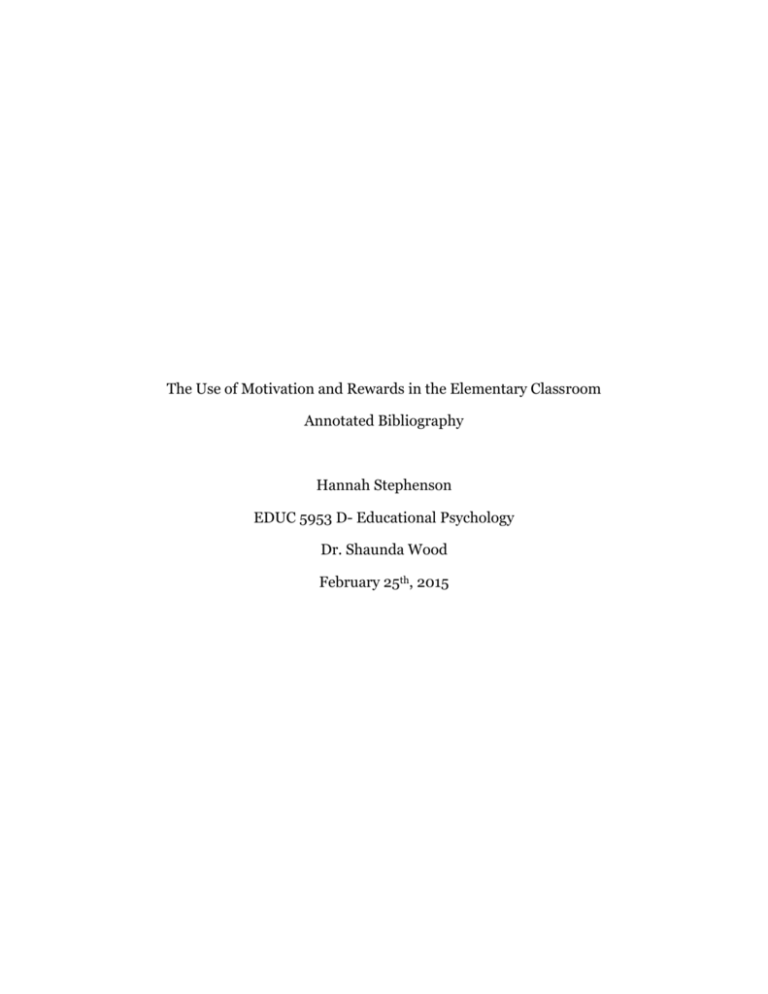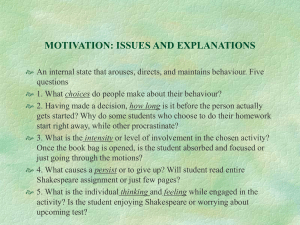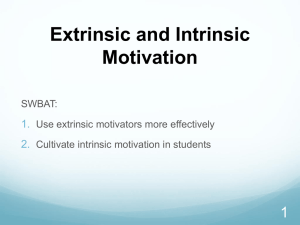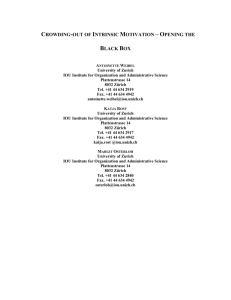File - Ms. Hannah Stephenson
advertisement

The Use of Motivation and Rewards in the Elementary Classroom Annotated Bibliography Hannah Stephenson EDUC 5953 D- Educational Psychology Dr. Shaunda Wood February 25th, 2015 2 Abstract The topic of motivation and rewards in the classroom appears to be an ongoing debate in regards to academic achievement. In this bibliography, I have included several different opinions, but focused my research on whether or not extrinsic motivation has an effect on a student’s intrinsic motivation. The articles I chose discuss motivation and rewards, and they all seem to take on the similar debate. One interesting article included in this annotated bibliography discusses the perception of a teacher with regards to the use of rewards in the classroom to encourage appropriate behaviour and academic achievement. 3 Bibliography Akin-Little, K.A., Eckert, T.L., Lovett, B.J., & Little, S.G. (2004). Extrinsic Reinforcement in the Classroom: Bribery or Best Practice. School Psychology Review, 33 (3), 344-362. This article defines intrinsic motivation as a behaviour in which “there exists no recognizable reward except the activity itself.” On the other side of the spectrum, AkinLittle et al. define extrinsic motivation as a “behaviour controlled by stimuli external to the task.” According to research, the past forty years have proven the success of using rewards in the classroom as a form of reinforcement. Researchers stated that reinforcement strategies used in the classroom may decrease the student’s perception of competence and self-determination. This decrease is referring to that of intrinsic motivation. Akin-Little et al. states that intrinsic motivation is observed when students do something because of interest, not because of an external reward. To conclude, research shows little detrimental effect with the use of extrinsic motivation such as rewards. If a teacher is using rewards in her/her classroom, research states that it is important to use best practice because the student’s deserve the best. Broussard, S.C., & Garrison, M.E.B. (2004). The Relationship between Classroom Motivation and Academic Achievement in Elementary-School-Aged Children. Family and Consumer Sciences Research Journal, 33(2), 106-120. The study focused on the relationship between classroom motivation and academic achievement. The research was conducted in the southern United States and was based on 122 1st grade students and 129 3rd grade students. According to Broussard and Garrison, research shows that higher levels of mastery motivation led to higher math 4 and reading performance grades in the 1st grade. The student’s level of motivation is a huge determinant of their level of success and quality of learning. Research indicated that one’s intrinsic level of motivation in early years can have a significant impact on future success. According to Boggiaro, Main, and Katz (1991), females were found to be significantly more extrinsically motivated than males. One year later in 1992, Schiefele, Krapp, and Winteler suggested that females academics are less associated with their interests unlike male students. With this, the study supports the hypothesis that intrinsic motivation is positively correlated to academic achievement. Habgood, M.P.J., & Ainsworth, S.E. (2011). Motivating Children to Learn Effectively: Exploring the Value of Intrinsic Integration in Educational Games. Journal of the Learning Sciences, 20 (2), 169-206. The study focuses on the concept of intrinsic motivation by using educational games for children to create a productive relationship with learning content in the classroom. An educational game, “Zombie Division”, was created for math students ages 7 to 11. In the study 1, 58 students were observed for 2 hours of choice time for either intrinsic, extrinsic, or control variants. In study 2, 16 children were allotted 2 hours and compared time on each task including intrinsic, extrinsic, or control variants. Results proved that children learned more from the intrinsic version of the game with a specific amount of fixed time. Children were reported as spending 7 times longer playing the intrinsic version of the game in free-time stimulation. Research indicates that there are advantages and disadvantages related to using educational games for learning. According to research, educational games can effectively motivate and engage children 5 in learning. The educational games can support and increase learning by gaining persistence, increased focused attention, and the development of alternative strategies. A possible disadvantage of educational games for children is that some may find it rather difficult to transfer their mathematical understanding from one context to another regardless if it is the same. Overall, research states that the integration of educational games was intrinsically motivating for children. Hoffmann, K.F., Huff, J.D., Patterson, A.S., & Nietfeld, J.L. (2009). Elementary Teachers’ use and perception of rewards in the classroom. Teaching and Teacher Education, 25 (6), 843-849. Despite the forty year debate about the effects of extrinsic motivation on intrinsic motivation in the classroom, it is evident rewards are still present in today’s classrooms to encourage student’s behaviour and level of academic achievement. This article focuses on the significant relationship between rewards, behaviours, and academic achievement from the teacher’s perspective. According to Hoffmann et al., Alfie Kohn (1996) indicates that the majority of teachers use rewards in their classrooms to regulate the student’s behaviour. Therefore, this tends to cause students to behave in a manner because of the reward. Judy Cameron (2001) indicates that the use of extrinsic motivation such as rewards do not affect the intrinsic motivation of students. The study asked the teacher participants if rewards have an appropriate place in the classroom. The majority of the teachers indicated that they believe in the use of rewards in the classroom because they encourage student good behaviour and academic achievement. The teachers who took part in the study stated that they generally used tangible rewards 6 in the classroom. Furthermore, the study indicated that rewards should be used on a conditional basis. Mata, L. (2011). Motivation for Reading and Writing in Kindergarten Children. Reading Psychology, 32 (3), 272-299. Research studies of Kindergarten children indicate that they have high motivation for both reading and writing. Children develop reading and writing early on which means they are likely to develop feelings and attitudes towards reading and writing at a young age. Reading Psychology states that a child’s motivation and attitudes play a significant role in their learning in the classroom towards literacy. Researchers mentioned that the child’s motivation towards reading and writing is primarily influenced by their parents through the enthusiasm that they convey towards literacy to their children. It is shown that when determining a child’s level of motivation, we need to consider that child’s cognitive and social aspects as well. The study showed that engaged readers, who read for pleasure, are motivated but as children get older, studies show that one’s intrinsic motivation often declines as they get older. According to Mata (2011), girls demonstrate higher levels of motivation whereas boys tend to be more motivated by competition. If teachers want to prevent this decline, researchers recommend providing students with the opportunity to understand the importance and purpose of writing. 7 McGeown, S.P., Norgate, R., & Warhurst, A. (2012). Exploring Intrinsic and Extrinsic Reading Motivation among Very Good and Very Poor Readers. Educational Research, 54 (3), 309-322. This article focused on the relationship between children’s reading skills and their motivation towards reading. Researchers tried to determine whether there were differences between children who were very good or very poor readers and their intrinsic and extrinsic reading motivation. According to research, children’s intrinsic motivation towards reading and reading efficacy was related with their reading ability whereas their extrinsic reading motivation was not. Research indicates that the children who are intrinsically motivated choose to engage in an activity because they find it interesting and/or enjoyable. On the other hand, extrinsically motivated children will only choose to take part in an activity if there is going to an outcome for them such as a reward or a better grade. This study identified the differences between boys and girls in regards to reading motivation. Girls demonstrate higher reading motivation than boys. A study in 2003 observed 2 groups of readers which led to the conclusion that good and bad reader’s level of intrinsic motivation differed significantly and their extrinsic level of motivation did not differ. The study suggested that teachers understand what motivates their students to become good readers.







